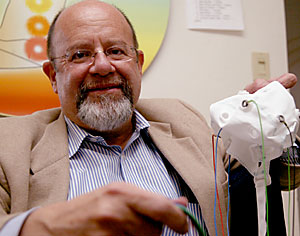 |
|
KEVIN KLAUS/Arizona Daily Wildcat
|
Gary Schwartz, a UA professor and director of the Center for Frontier Medicine in Biofield Science, holds a cap used to measure brain waves. Schwartz is conducting a study on the effects the human heart of one person has on another person.
|
|
|
By Sarah Stanton
Arizona Daily Wildcat
Monday, February 23, 2004
Print this
The existence of an afterlife is a mystery that has plagued religion, philosophy and psychology since their conception - until now.
For seven years, Gary Schwartz, a UA professor and director of the Center for Frontier Medicine in Biofield Science, has been conducting afterlife experiments and research that he believes prove the survival of human consciousness after death.
"When you look at the totality of the data, the simplest and most parsimonious explanation that accounts for the largest amount of data is the survival of consciousness hypothesis," he said.
The experiments are performed in a lab with a medium, a sitter and Schwartz. A medium is someone who believes that he or she can communicate with the dead, and a sitter is a person who wishes to gain knowledge about a deceased loved one.
The medium receives messages from the dead and then relays them to the sitter, who tells Schwartz if the information is correct or incorrect. These messages can include the deceased's cause of death, memories that include the deceased and the sitter and "signs" for the sitter that indicate the deceased is around him or her.
After the experiment, Schwartz analyzes the data and determines the accuracy of the medium's reading.
In this process, he rules out information that the medium got about the deceased before the experiment or that the medium got with clues from the sitter. Schwartz also rules out any information that may have involved cheating or fraud.
"Our motto is, 'If it is real, it will be revealed, and if it is fake, we will find the mistake,'" he said.
Schwartz has tested many mediums in his research, including John Edward, host of the TV show "Crossing Over," in which Edward contacts deceased relatives of audience members.
"To my great surprise, what he does in the lab under controlled conditions is what he does on TV," Schwartz said.
One of the most accurate mediums Schwartz has worked with is Allison DuBois, an ASU graduate and mother of three whom Schwartz calls a "Michael Jordan of the mediumship world."
DuBois' accuracy is between 70 percent and 90 percent.
"I have successfully read for major celebrities, scientists, skeptics, TV producers and even a documented university test with Deepak Chopra," DuBois states on her Web site.
DuBois has become so famous that Kelsey Grammer of "Frasier" has bought the rights to her life story, which he plans to make into an NBC show. A pilot is currently being filmed, with Patricia Arquette playing DuBois. Schwartz will also be a character on the show.
At the UA, Schwartz is also performing experiments to determine the nature of the afterlife. In this research, the medium asks the deceased a series of 30 questions, including, "Where are you? What do you see? Do you sleep? Do you have sex?"
Schwartz says the data from these experiments are "extremely interesting," but more data needs to be collected before any conclusions can be drawn.
He acknowledges that it can be difficult for people to believe that consciousness survives death, and that mediums can communicate with the dead.
"I have something called 'PESD,' or Post-Education Stress Disorder. I was taught throughout school that this stuff is impossible, and I think a lot of other people were too. But how much data do you have to see before you accept a new vision?" Schwartz said. "The psychology department is to be commended for honoring academic freedom and for allowing science to function as it's meant to function, which is allowing the data to speak for itself."
Some UA students are skeptical of these afterlife experiments.
Sean Harris, a journalism junior, said, "I think it's a waste of the UA's money. For funding, they should turn to the suckers who believe in this crap. I've seen that show 'Crossing Over,' and it's such a joke."
But Schwartz said his research is controlled and scientific.
"We're a real research laboratory," he said. "It's a gift and a privilege to be able to do this kind of work."
Tonight, Schwartz will emcee a lecture on extraterrestrial life - another controversial topic in science.
The free lecture and screening, titled "Evidence for Extraterrestrial Life?" will be held in University Medical Center's Duval Auditorium, 1501 N. Campbell Ave., at 7:30 tonight.
It will include two documentaries: "The Phoenix Lights," by Dr. Lynne Kitei of the Arizona Heart Institute, and "Touched," featuring Dr. John Mack, professor of psychiatry at Harvard. Kitei and Mack will introduce their films, answer questions and sign books. The event is free and open to the public.
